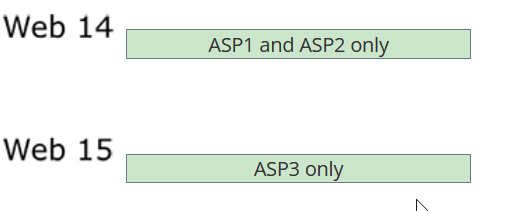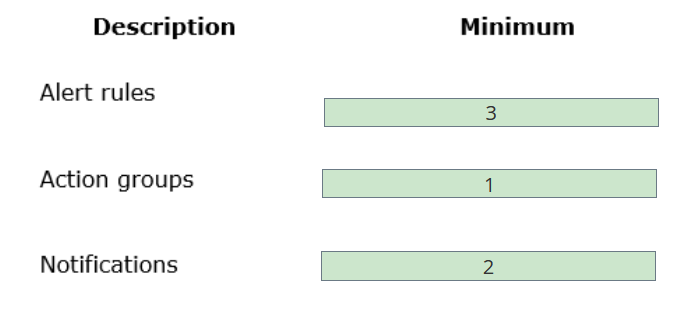AZ-104 Meaureup Study Set 1
1/13
There's no tags or description
Looks like no tags are added yet.
Name | Mastery | Learn | Test | Matching | Spaced |
|---|
No study sessions yet.
14 Terms
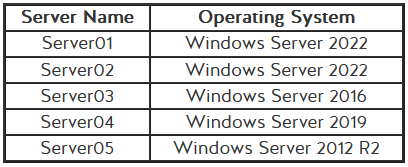
You work for a company that has an on-premises infrastructure that currently uses Windows servers to facilitate file sharing with its users. You plan to migrate the file share service to Azure Files and map the file share to the on-premises servers. Information about the existing on-premises Windows servers is shown in the table below:
Before mounting the file share you need to evaluate each of the servers and decide which ones are recommended to be used with Azure Files and which ones need to be upgraded.
Server Name: OS:
01 Windows Server 2022
02 Windows Server 2022
03 Windows Server 2016
04 Windows Server 2019
05 Windows Server 2012 R2
How should you evaluate each server?
To answer, select the appropriate options from the drop-down menus.
S
S
R
S
R
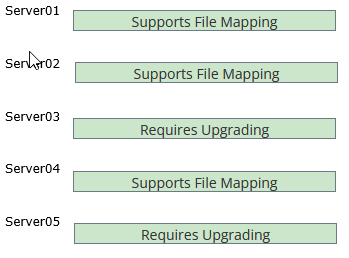
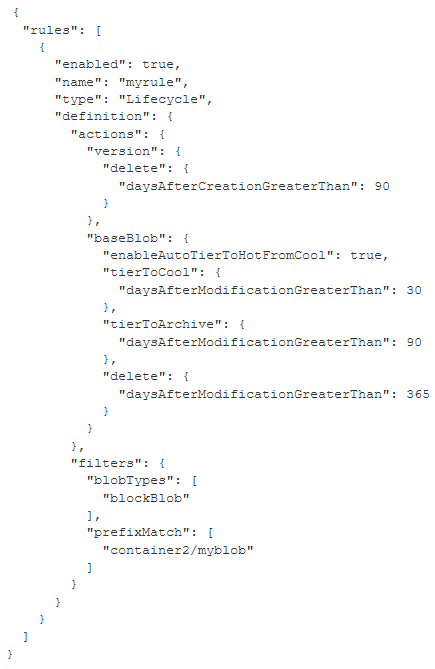
Your company implements block blog storage in general-purpose version 2 (GPv2) storage account and uses the following rule to help optimize storage costs.
You need to configure how blob storage is configured by this rule.
For each of the following statements, select Yes if the statement is true. Otherwise, select No
Previous blob versions are deleted automatically 90 days after creation.
Rehydrating a blob from archive with a Copy Blob operation resets the days after modification counter to zero.
You should transition blobs from cool to hot tier storage to optimize performance.
Y
N
Y

You create a Windows Server virtual machine in an Azure resource group named iaas-rg. You plan to generalize the operating system ans capture an image for use in future deployments.
You need to ensure that other administrators make no changes tot he virtual machine configuration until you complete the image capture process. You need to enact your solution as quickly as possible.
What should you do?
Set a Delete lock at the VM level.
Edit the role-based access control (RBAC) permissions at the resource group level.
Set a Read-only lock at the resource group level.
Edit the role-based access control (RBAC) permissions at the VM level.
Set a Read-only lock at the resource group level.
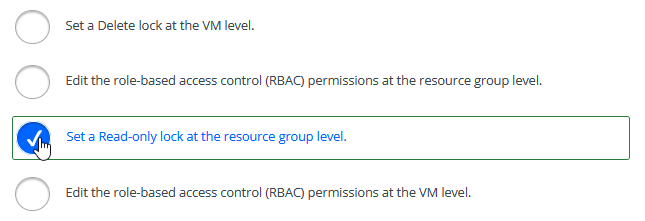
Your company has a custom line-of-business (LOB) application that uses several Azure resources. All resources assigned to the LOB application are in the same resource group. After the first deployment of the LOB application, the company adds more features to the application. You also add more resources to the resource group in different additional deployments.
You need to create a template to redeploy the resources needed for the LOB application.
What should you do?
Use the Get-AzResourceGroup Deployment cmdlet.
Use the Save-AzResourceGroup DeploymentTemplate cmdlet.
Use the Export-AzResourceGroup cmdlet.
Use the Get-AzResourceGroup DeploymentOperation cmdlet.
Use the Export-AzResourceGroup cmdlet.
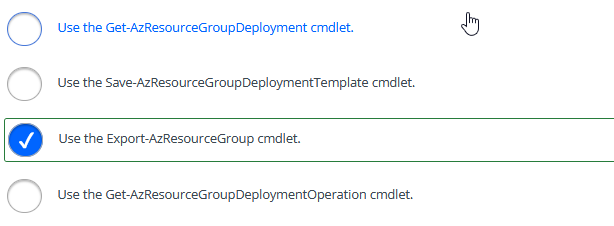
You have an Azure Resource Manager (ARM) template for creating a Windows virtual machine. You got this template from an existing resource group with a single virtual machine, using the automation script option.
You want to reuse this template for other deployments. You need all the resources in the resource group to be in the same location.
What should you do?
Choose the correct answer
Use the New-AzResourceGroup cmdlet with the location parameter to create a resource group in the desired location. Then use the New-AzResourceGroup Deployment cmdlet using the newly created resource group.
Edit the template file and update each location parameter with the value [resourceGroup().location].
Use the Azure portal and create a resource group in the desired location. Then use the New- AzResourceGroup Deployment cmdlet using the newly created resource group.
Edit the parameters file and add a new parameter named location of type string with the default value of [resourceGroup().location].
Edit the template file and update each location parameter with the value [resourceGroup().location].
You create an Azure virtual machine (VM) scale set named Scaleset1. The scaling configuration is shown in the exhibits. The date format is month/day/year.
As shown in the exhibits, there are three scale conditions:
1. A default scale condition with an overview of the default scale condition, details for scaling out, and details for scaling in
2. Specific scale condition 1
3. Specific scale condition 2
You need to check the configuration.
What should the observed capacity metric be in the following three scenarios? To answer, select the appropriate options from the drop-down menus.
Choose the correct options
On Wednesday 06/10/2020 the scale set instance count is stable at 3 instances for 2 hours. In this period CPU usage is between 50 and 60%. After this period, CPU usage is 80 percent on average for 11 minutes. What will be the value of the observed capacity metric? [1-6]
On Monday 04/06/2020 CPU usage on the scale set instances is between 50 and 60% for 2 hours. After this period, CPU usage is 80 percent on average for 11 minutes. What will be the value of the observed capacity metric? [1-6]
On Tuesday 05/05/2020 the scale set instance count is stable at 3 instances for 4 hours. In this period CPU usage is between 40 and 60 %. After this period, CPU usage is 10 percent on average for 6 minutes. What will be the value of the observed capacity metric? [1-6]
4, 6, 2
Your company has an Azure subscription. You create an Azure Log Analytics workspace (Azure Monitor log) and collect data from various data sources. You run an Azure Monitor log query. You want to display the tabular data as a chart pinned to a shared dashboard.
You create an Application Insights Overview dashboard.
You need to identify restrictions when pinning a result chart to a dashboard.
For each of the following statements, select Yes if the statement is true. Otherwise, select No.
Statement (Yes/No)
Data displayed in the chart is limited to no more than 30 days.
Data displayed in the chart is limited to up to four columns and the top seven rows.
Chart types are limited to line and stacked column only.
Yes
No
No
You have two storage account keys: key1 and key2. Your apps and services use key1, and you maintain key2 as a backup key.
You are concerned that both keys may have been compromised. You want to use the Azure portal to regenerate them without interrupting access to the storage account.
Which five actions should you perform in sequence? To answer, move the appropriate actions from the list of possible actions to the answer area and arrange them in the correct order.
Verify that all apps and services are running correctly using the new key.
Update connection strings in all relevant apps and services to use key2.
Create a new Key using the Azure Portal called key3
Regenerate key2 using the Azure portal.
Update connection strings in all relevant apps and services to use key1.
Regenerate key1 using the Azure portal.
1. Regenerate key2 using the Azure portal.
2. Update connection strings in all relevant apps and services to use key 2.
3. Regenerate key1 using the Azure portal.
4. Update connection strings in all relevant apps and services to use key 1.
5. Verify that all apps and services are running correctly using the new key.
You are the administrator for your Azure subscription. Your company hires a new cloud engineer.
The cloud enginee needs to be able to manage other engineers' access to Azure resources. You need to follow the principle of least privilege.
Which role should you assign to the new engineer?
Choose the correct answer
Co-Administrator
User Access Administrator
User Administrator
Contributor
Owner
User Access Administrator
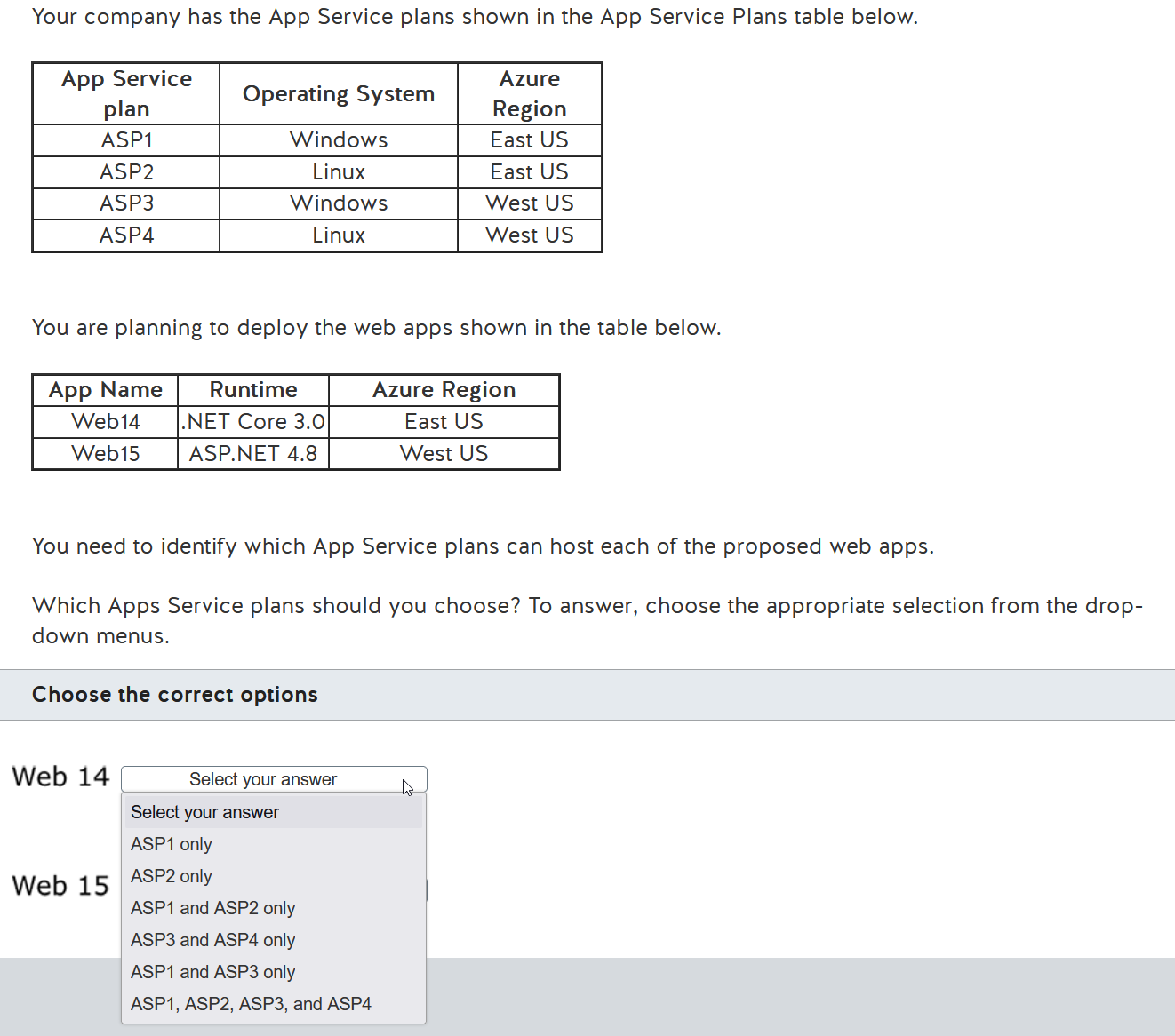
Your company has the App Service plans shown in the App Service Plans table below.
You need to identify which App Service plans can host each of the proposed web apps.
Which Apps Service plans should you choose? To answer, choose the appropriate selection from the drop- down menus.
Web 14: ASP1 and ASP2 ONLY
Web 15: ASP3 ONLY
